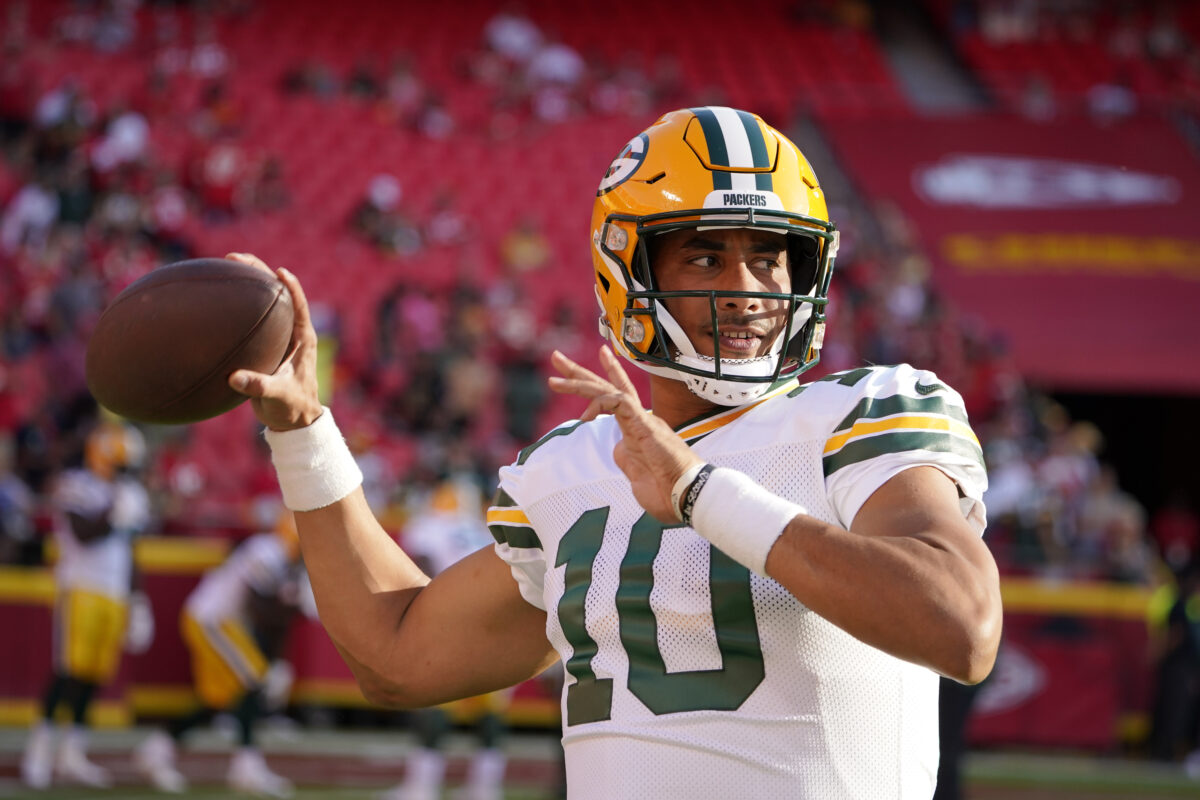[anyclip pubname=”2103″ widgetname=”0016M00002U0B1kQAF_M8036″]
Change. It’s inevitable, and the Green Bay Packers are experiencing quite a bit of it on the offensive side of the ball this offseason.
Most notably, Aaron Rodgers has been traded to the New York Jets, meaning that Jordan Love will take over as the starter. But on top of that, this is a unit that has lost a number of veteran pass catchers, including Allen Lazard, Randall Cobb, Robert Tonyan, and Marcedes Lewis.
So naturally, when the personnel of a football team changes somewhat drastically, especially when the pendulum swings from being a veteran-heavy roster to one loaded with inexperience, changes to the playbook to varying degrees are likely to follow.
“It might, yeah, it might,” said offensive coordinator Adam Stenavich when asked if the offense might look quite different this season. “I think it might. And it’s not just because of not having Aaron Rodgers. It might just be these other pieces that we’ve added as well. So, again, it’s OTAs right now, so we’re just going to kind of see how it all fits, and once we figure out kind of how we’re going to attack defenses, then we’ll roll from there. But I think it might.”
So what does different mean? Most assume that for the Packers in 2023, it means we see a more pure version of the Matt LaFleur offense after it had previously been mashed together with what Rodgers was comfortable running. This could mean more motion, fewer snaps from shotgun, and greater reliance on the run game, as well as fewer pre-snap adjustments at the line of scrimmage.
However, before that can be determined, the Packers will utilize OTAs, training camp, and the preseason to lay the groundwork for what they want – and hope – the offense can become. This includes seeing where Love excels and where he has to improve. Building off one while attempting to make strides each day in the other.
“I think from the quarterback position, you just take a step back as far as, like, now we’re starting on Step 1 instead of starting at Step 8, where you can start with Aaron Rodgers,” said Stenavich via Packers.com. “So, you’re going to take a step back, and you’re just going to keep working ahead. Can’t really look at the end result right now. We’re just going to look at one day at a time and just go from there, but he’s ready; he’s excited. I think all the guys, you can feel good vibes, good energy around the locker room, so it’s going to be fun.”
The same approach will have to be taken with the Packers’ young receivers and tight ends. From a pass-catching standpoint, Josiah Deguara is the most experienced tight end on the roster with 39 receptions, and Rome Doubs is the most experienced receiver with 42 receptions. Rather than trying to force the rookie receivers and tight ends to play a certain way or ask them to do too much, the coaching staff will first figure out their strengths and, from there, do their best to put the pass-catchers in positions to be successful. Oftentimes this means keeping things simple, so that players can simply make plays.
“You have to limit what you put on their plate initially,” said Stenavich of the young pass catchers. “See what they’re good at, what they excel at, and use that as their strengths. Then you can work on things that they need to improve as you go along. But I’m really excited about all of those guys. Watching them run around rookie minicamp was pretty impressive, so I’m fired up for them.”
The Packers offensive coaching staff spent some time this offseason watching the San Francisco 49ers, specifically, how they schematically enabled Brock Purdy, a seventh-round rookie in 2022, to come in and have so much success, which included almost instant control of the Niner offense and an NFC Championship appearance.
Studying like-offenses is common practice in the NFL — San Francisco wasn’t the only team the Packers studied — with the hopes that a specific play, or series of plays, can be borrowed and incorporated. Although Love is entering his first season as a starter, and the foundation for what the offense is going to become still has to be laid this summer, the potential benefit of having him sit and develop for three years is that the learning curve will shrink, and the depth of the playbook expands much sooner.
“Obviously, he doesn’t have the playing experience that Aaron had, but from a playbook standpoint, I think pretty much all of it’s on the table,” Stenavich told reporters. “He’s been around for three years and has really attacked it. Even last year, you could see him come into his own, felt a lot more comfortable, so this year he’s really hitting it on all cylinders, so I’m really excited to see what he’s going to bring.”
Step one to this entire process begins on Monday, when OTAs officially are underway, and the Green Bay Packers will have a majority of their 90-man roster on the practice field. Unlike in past seasons where the bulk of Green Bay’s starting contingency has sat out during the preseason, those reps in 2023 will be incredibly valuable for Love and his young skill position players as the Packers continue to learn their strengths and build this new-look offense — whatever that may end up looking like.
“I think the preseason, that’s going to be very important,” Stenavich said. “But just going out there, getting him around all these young receivers and tight ends and stuff, and working with our vets and just kind of allowing him to put his leadership on there, put his stamp on it, and then once we see how it’s going, then you can go in that direction.”
